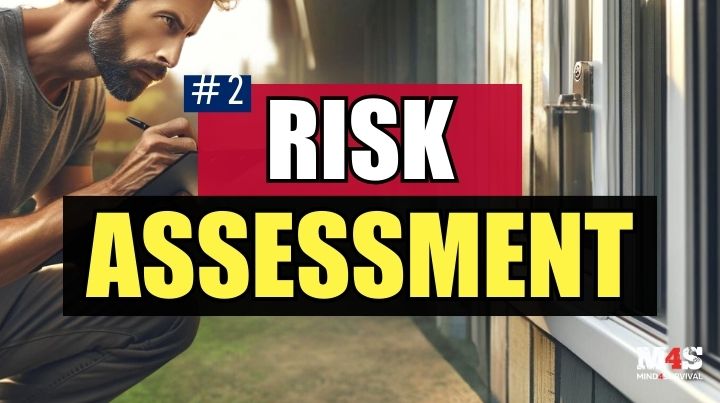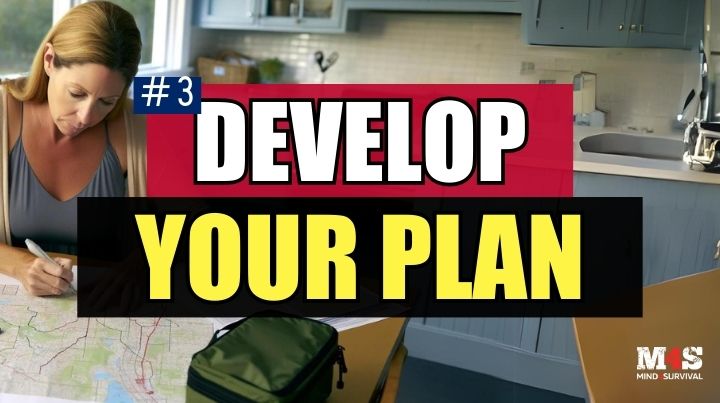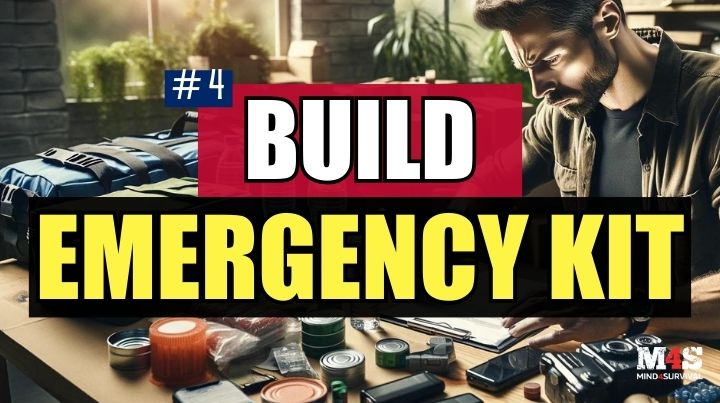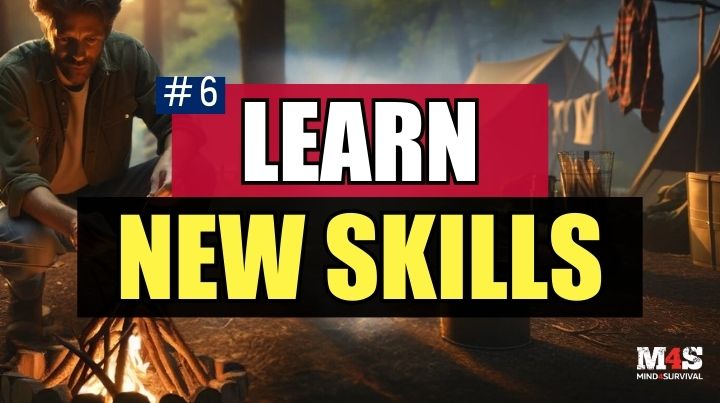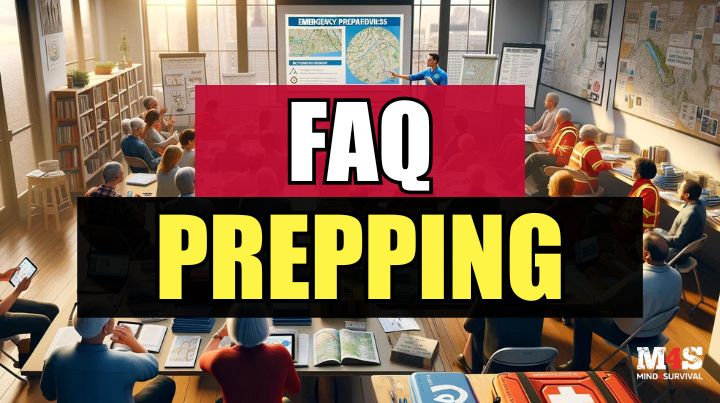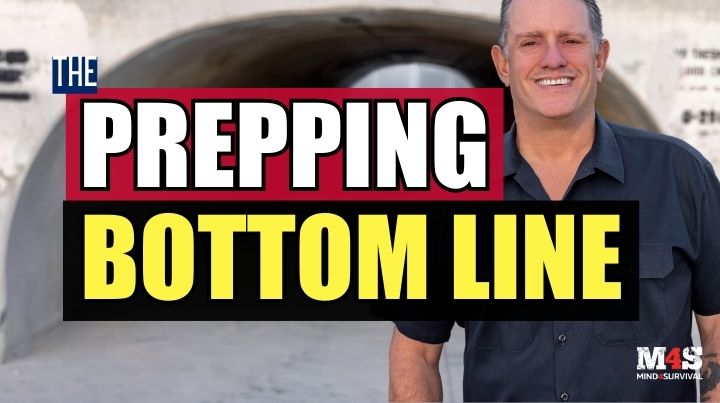The 7 Prepping Essentials (What You Need to Know)
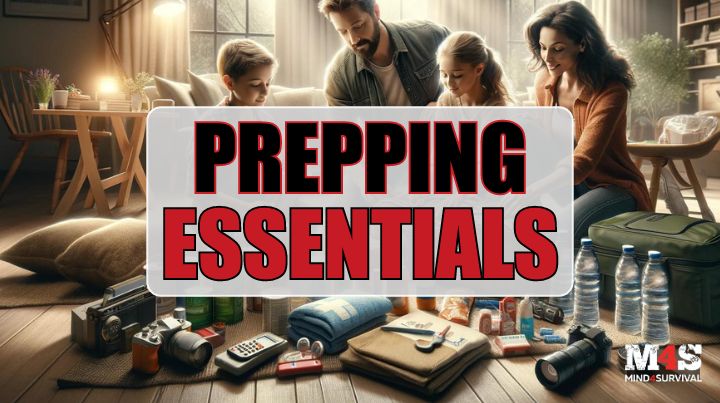

Podcast: Play in new window | Download
Are you ready to start prepping so that you're ready for anything life throws at you? If so, you’ve come to the right place.
Prepping is for everyone, including everyday folks like you and me who want to be prepared for both big disasters and life’s little curveballs.
Drawing on my extensive background in security, crisis management, and preparedness, from serving as a Special Operations team leader to advising international security operations, working as a paramedic, and a bachelor's degree in Security Management, I'll distill my real-world experiences into practical advice for enhancing your outlook and strategy on prepping.
Prepping is the effort preparedness-minded people make to become more safe, confident and self-reliant so that they and their families are prepared to face any crisis, minimize their unwanted struggles, and live their best possible lives.
As such, prepping involves taking the proactive steps necessary to identify and manage potential risks by increasing one’s capability to thrive in any situation. Contrary to the belief of many, that doesn’t only apply to survival situations. Instead, it applies to all of life’s challenges. Prepping prepares people to deal more effectively with job loss, medical problems, car troubles, family issues, and the occasional SHTF disaster.
The Definition of Prepping
I define preparedness as:
All the efforts taken to ensure survival, minimize unwanted struggle, and live their best possible life.
Why Should a Person Start Prepping?
Understanding the need to be ready at only a moment's notice, preparedness involves recognizing the unpredictability of emergencies and their potential impact on our lives. It’s well-known that being unprepared can lead to dire circumstances, especially when emergency services and aid organizations are overwhelmed. As such, self-reliance and personal responsibility are vital to guaranteeing our well-being and that of our loved ones.
Emergency Prepping Reduces Stress
Emergency preparedness also reduces the stress and anxiety on ourselves and our loved ones by providing a sense of control and peace of mind. As a result, it enables us to approach disasters with strength, confidence, and a positive can-do attitude. This proactive mindset not only increases our chances of survival but also fosters a sense of unity and cooperation among family members and communities, which is crucial during challenging times.
Stressed Out About Prepping: Learn How to Manage Stress & Anxiety in Preparedness
Three Goals of Prepping
As discussed in the definition, the goals of preparedness are survival, minimizing unwanted struggle, and living the best life possible.
- Survival involves avoiding massive trauma and maintaining homeostasis.
- Minimizing unwanted struggle involves reducing difficulties in life, such as health problems, financial difficulties, disasters, personal loss, relationship issues, addiction, etc.
- Living your best possible life involves experiencing love and belonging and proactively pursuing personal growth and happiness.
In short, the purpose of prepping is to succeed at the goals of preparedness by positioning oneself to minimize problems while maximizing opportunity.
What Are the Basics of Prepping?
The basics of prepping can best be summarized as the fundamentals of preparedness. The fundamentals of emergency preparedness are mindset, situational awareness, survival, safety, and self (M4S). Together, these fundamentals provide an easy-to-remember, step-by-step guide for managing your prepping.
The M4S system of emergency preparedness fundamentals is helpful for seasoned preppers and those just now ready to begin preparing. By using the M4S prepping system, you’ll be sure to cover everything from your most basic prepping needs to creating quality emergency plans to help yourself and your family members survive multiple weeks or more on your own and unassisted.
Here’s a Deep Dive into the Fundamentals of Prepping
What is a Prepper?
Preppers are individuals who actively prepare for a potential emergency, such as a natural disaster or a man-made catastrophe. They focus on self-sufficiency, self-reliance, and the independence to thrive in any circumstances.
Unfortunately, many newcomers to emergency preparedness are hesitant to become better prepared because they are concerned about being labeled a prepper. This concern arises from the negative stereotypes perpetuated by the media and others in society that equate preparedness.
Fortunately for those who want to become better prepared, doing so does not mean embracing extreme beliefs or accepting the prepper label. Instead, becoming better prepared simply involves taking positive steps to enhance the safety, security, and resilience of oneself and one’s family.
On that point, I like to remind people that:
while every crazy prepper is into preparedness, not every preparedness-minded person has to be a crazy prepper.
Here’s Where I answer the Question: Are Preppers Crazy?
2: Assess Your Risk
Risk Management, the process of objectively managing your risks, is essential for achieving a balanced approach to preparedness. By objectively assessing the risks associated with what you want to protect, you can determine where to focus your preparedness efforts.
The Three Risk Management Questions
As my good friend and Risk Management expert, Ed Clark, CEO of Executive Interface, teaches:
Risk can be summarized by asking yourself these three questions:
- What do I have to protect? (This will tell you the assets/things you are protecting)
- What do I have to protect it from? (This will tell you your threats)
- What do I have to protect it with? (This will tell you your vulnerabilities)
The objective risk management process involves quantifying the impact of potential losses, the ability of threats to cause harm, and the level of vulnerability of each asset. By using these risk factors as inputs into the risk formula, you will be able to calculate a risk score specific to each asset (a thing you value).
Then, with your risk scores calculated, you can easily rank which assets are at the greatest risk, providing you with an objective and holistic view of your overall risk profile. This objective data and holistic understanding of your risk profile will help guide your decision-making process with regard to the allocation of your resources, such as time, money, and supplies.
Spurious Risk Management
Without a structured risk management approach, decisions become subjective and emotional, leading to what is known as spurious risk management. By prioritizing areas of higher risk based on objective analysis, you can mitigate vulnerabilities and improve your preparedness in a logical, well-thought-out manner. In the end, objective risk management decreases your overall risk and enhances your ability to avoid and handle emergencies as effectively and efficiently as possible.
Here’s my Mind4Survival Guide to Understanding Risk Management
3: Develop a Plan
Creating a comprehensive plan is crucial for effective prepping. This plan should cover a variety of scenarios identified in your risk assessment. This plan will be the guide for your preparation efforts.
1. Outline specific actions for each identified risk. For example, for a natural disaster, detail your evacuation routes, safe meeting points, and emergency contacts. In the case of economic trouble, plan for financial reserves, asset diversification, and skills that could provide alternative income sources.
2. Create a communication strategy in your plan. Determine how you will stay in touch with family members if conventional methods fail. Consider alternative communication tools like satellite phones or ham radios.
3. Expanding on your emergency kit by stockpiling essentials is another key element. List necessary supplies such as water, food, medication, and anything you and your family need to maintain as normal of a life as possible. Remember, the goal is readiness to be self-sufficient for several weeks or more.
4. Practice your plan regularly. Drills can reveal gaps in your strategy and help familiarize your family with the procedures, reducing panic in real situations.
4: Build an Emergency Kit
As someone who's spent decades dealing with life-and-death survival situations, I've seen firsthand how crucial a well-prepared kit of emergency supplies can be. Here's how to build one based on the Survival Pyramid, and in so doing, ensure you're ready to face any challenge.
1. Mindset
Before diving into the physical items of your survival kit, remember that your mindset is your primary survival tool. Cultivate resilience, adaptability, and a proactive attitude. These mental attributes form the foundation of your emergency preparedness, enabling you to make effective decisions under pressure.
2. Situational Awareness
Your kit should start with items that enhance your ability to assess your environment quickly. A durable, waterproof flashlight, a GPS or compass along with a map, and a radio to receive up-to-date information can be lifesavers, helping you to navigate and make well-informed decisions quickly.
3. Immediate Action Supplies
For scenarios requiring swift action, include a high-decibel whistle, a self-defense item, and a reliable multi-tool in your kit. These items can help you signal for help and protect yourself if you find yourself in a devolving situation.
4. Oxygen to the Brain
As a paramedic who has treated 100s of trauma victims, I know for a fact that your ability to keep oxygen-enriched blood in the body and carry oxygen to the brain is a critical survival skill. Therefore, survival kits should include quality tourniquets, hemostatic dressings, pressure bandages, CPR masks, and chest seals. Likewise, gear without the knowledge and skill to use it is a recipe for disaster. So, get training on CPR and emergency bleeding control techniques to complement your supplies.
5. Shelter
To shield yourself from environmental threats, pack lightweight, waterproof clothing and a sturdy pair of gloves. Also, add a compact emergency blanket or shelter to your kit, ensuring you can protect yourself and others from the elements.
Read This Article For More Information About Emergency Shelter Considerations.
6. Hydration and Sleep
You can't go longer than 72 hours without water or sleep before suffering side effects. Water purification tablets, a way to boil water, or a compact, durable water filter, such as the Sawyer Mini, are must-haves. Sleep is the often overlooked part of survival planning. To help with sleep, I also make sure to pack my tried and proven trusty poncho liner with me. These items will help you stay hydrated and rested, which is crucial for maintaining your physical and mental health in an emergency.
Read This Helpful Guide on How to Source Water During an Emergency.
7. Food
Stock your kit with high-calorie, nutrient-dense emergency food bars with a long shelf life. Are they the most enjoyable food? No, but it's food that will keep you fueled and going for several days during an emergency. Look for food options that offer a balance of protein, fats, and carbohydrates to sustain your energy levels. Know how many calories you have in your kit so that you can plan your meals accordingly.
Start Your Survival Pantry
I like to use the “20-20-20-20” can method to jump-start your own food stockpile. It's easy to do and budget for and establishes a solid foundation for your long-term food storage pantry. Start your survival pantry by purchasing these items:
- 20 cans of vegetables
- 20 cans of fruit
- 20 cans of meat
- 20 cans of whatever else your family enjoys eating
8. Society: Supplies to Communicate
While you can't pack a community into your kit, you can include a durable, hand-crank emergency radio to stay informed and a compact set of writing materials to leave messages or keep a journal. Communication and information are key to connecting with others and keeping yourself informed.
Final Thoughts on Your Emergency Kit
Building survival kits is a dynamic process that reflects the unique challenges you may face. Review and update your kit regularly, tailoring it to your evolving emergency preparedness needs and the insights gained from continuous learning and practice.
How to Always Have Needed Supplies: Two is One, One is None
5: Home Security
In the face of increasing uncertainties, from a natural disaster to societal unrest, fortifying your home becomes a critical step in prepping. The concept of fortification encompasses enhancing the security of your property's perimeter, exterior, and interior to withstand various threats effectively. This step involves a comprehensive approach, starting from the outermost boundaries of your property to the inner sanctum of your living spaces.
1. Perimeter Security: Begin by securing the perimeter of your property. This can include installing fences that are tall and difficult to climb, setting up driveway sensors to alert you of any intrusions, and implementing perimeter lighting to deter unwanted visitors. Additionally, consider the strategic use of dogs as both a deterrent and an early warning system.
2. Exterior Fortification: Focus on reinforcing the exterior of your home by ensuring doors are solid and secure, with reinforced frames and high-quality locks. Pay special attention to garage doors and windows, which are common entry points for intruders. When your budget permits, utilize security film on windows to prevent easy break-ins, and consider upgrading to metal doors for enhanced protection.
3. Interior Defense: Inside your home, prioritize the installation of solid core doors for key areas, potentially transforming a room into a safe haven or “safe room” equipped with necessary supplies for emergency situations. This room should be fortified against forced entry and possibly include an independent air supply in extreme cases.
4. Comprehensive Security Measures: Beyond physical barriers, integrate security cameras and home security systems for continuous monitoring and alerting capabilities. These systems can be tailored to your specific needs, providing peace of mind and situational awareness through real-time surveillance and detection of potential threats.
By fortifying your home, you not only prepare for the possibility of SHTF events but also enhance your resilience against everyday security challenges. This proactive approach ensures that your home remains safe and secure for you and your family, regardless of what uncertainties lie ahead.
Visit Security.Org for More Information on Comprehensive Security Measures.
6: Learn Essential Survival Skills
Acquiring survival skills is as vital as gathering supplies. This step dives into fundamental abilities every prepper should master: first aid, fire starting, water purification, shelter construction, and finding your way without modern aids. These competencies are pivotal for thriving in adverse conditions.
1. Conflict De-Escalation: It is essential to understand how to defuse tense situations without resorting to physical confrontation. Conflict de-escalation focuses on calming aggressive behavior and resolving disputes through communication. Key strategies include maintaining a calm demeanor, using non-threatening body language, and actively listening to the other party's concerns.
2. Self-Defense: While avoiding conflict is preferable, knowing how to protect yourself is necessary. Self-defense encompasses a range of techniques to defend against physical attacks. Regular training ensures you can respond effectively if faced with a threat, prioritizing your safety and that of others.
3. First Aid: Grasping basic medical procedures can be life-saving. Learn to treat both life-threatening and non-life-threatening wounds, such as managing fractures and recognizing signs of common medical problems.
4. Fire Starting: The ability to start a fire under any weather condition is crucial for warmth, water purification, and food preparation. Experiment with different techniques, from matches and lighters to flint and steel, to ensure you can create a flame when needed.
5. Shelter Building: Knowing how to construct a temporary shelter using natural or man-made materials can protect you from the elements. Practice building shelters in different environments to adapt quickly in any situation.
6. Water Purification: Clean drinking water is a necessity. For planning purposes, I plan on each adult in my home to require one gallon of drinking water per day. Therefore, familiarize yourself with various purification methods, including boiling, chemical tablets, and filtration systems. Practice these techniques to make unsafe water drinkable.
7. Navigation: Modern technology might not always be available. If it isn't, many people's ability to navigate to unfamiliar areas may become impaired. To prevent becoming lost and unable to help your friends and loved ones, learn how to read a map and use a compass. Practicing skills in reading natural landscapes for direction can also be invaluable when you have to get somewhere new.
7: Monitor and Control
The last step in your prepping journey emphasizes the need for ongoing vigilance and adaptability. It's crucial to regularly check and revise your prepping strategy and supplies. Life changes, as do the challenges we might face. This step guides you to stay alert to new threats and adjust your plans to fit changing conditions and knowledge.
Stay Informed: Keep an eye on current events and emerging risks. Information is power, and in our fast-paced environment, staying informed helps you anticipate and prepare for evolving dangers.
Review Supplies: Periodically assess your stockpile. Check expiration dates, condition of gear, and relevance of supplies. Replace, replenish, and update as needed to maintain readiness.
Adapt Plans: As your life evolves, so should your prepping plan. Changes in family size, location, or financial status may require adjustments to your strategy. Reevaluate your risk assessment and modify your plan to align with your current situation.
Learn and Grow: Embrace new skills and knowledge. The more you know, the better prepared you are. Continuous learning aids in refining your prepping approach, making it more effective against diverse challenges.
Prepping FAQ
1. What is a Bug-Out Bag?
Bug-out bags (BOB) are emergency kits that you design to provide essential resources in a sudden evacuation or crisis situation. These bags can be thought of as a person’s prepper kit and typically include everything someone needs to meet the requirements of the Survival Pyramid: self-defense weapons, first aid supplies, clothing, water, emergency food, and other necessities to sustain an individual for a short period, allowing them to quickly “bug out” and reach safety.
Looking for Some Bug Out Bag Ideas? Here’s a List of the Essentials
2. What is Bugging In?
Bugging In refers to the strategy of staying at one’s own home or primary residence during a crisis. The decision to Bug In is based on the assessment that remaining in place is safer and more advantageous than attempting to evacuate the area (see Bugging Out).
Read the M4S: Guide to Bugging-In
3. What is Bugging Out?
Bugging Out is the strategy of quickly leaving (evacuating) one’s home or primary residence during a crisis or emergency to seek safety and shelter elsewhere. This decision is based on the assessment that staying in place is too dangerous or unsustainable, and evacuating to a different location would be the best course of action. In the prepping community, Bugging Out is also known as Get Out of Dodge (GOOD).
Bugging Out typically involves having a predetermined Bug-Out Location (BOL), such as a remote cabin, a friend’s house, or a designated community shelter, where individuals or families can find relative safety and resources away from the immediate threats. To execute this strategy effectively, people should have a vehicle or Bug-Out Bag (BOB) prepared with essential supplies, tools, and equipment needed for the journey and initial stay at the BOL.
Can’t Decide When to Go? Here Are My Thoughts on Bugging-In vs. Buggin Out
4. What is a Bug-Out Location?
A bug-out location (BOL) is a predetermined safe haven that preppers plan to move to in case of a crisis, disaster, or SHTF event. The purpose of a BOL is to provide a secure and sustainable place for an individual and their family to reside when their primary residence becomes unsafe or uninhabitable due to unforeseen circumstances.
A well-chosen BOL typically has access to essential resources such as a clean drinking water supply, emergency food storage, and shelter and is securely and strategically located away from potential threats or high-risk areas. It may be a remote cabin, a friend’s house, or another location that you prepare to allow everyday life to continue as normal as possible during an emergency.
Are Bug-Out Locations Too Expensive? Check Out This Budget Friendly Option
5. What is Everyday Carry?
Everyday Carry (EDC) refers to the essential items and tools that an individual carries on their person daily, ensuring they are prepared for various situations or emergencies that may arise at a moment’s notice. The purpose of EDC is to act as an essential aspect of personal readiness, safety, and efficiency in day-to-day life.
EDC items typically include practical and functional objects such as:
- cash
- pocket knife
- flashlight
- multi-tool
- personal defensive items, etc.
Here’s a How-to Article on Everyday Carry Essentials!
6. What Happens if the Power Grid Goes Down?
A Grid Down Event is a large-scale disruption or failure of the electrical power grid, causing widespread power outages. Possible causes include grid failure due to disrepair, Coronal Mass Ejections (CMEs), Electromagnetic Pulses (EMPs), High-Altitude Electromagnetic Pulses (HEMPs), and terrorist attacks on power company resources and weak points within the electrical grid. CMEs are massive solar bursts, while EMPs and HEMPs result from nuclear explosions or non-nuclear devices.
Because modern society must have electricity to function, an extended grid-down event will prove catastrophic. Think about everything you use that requires electrical power. Homes will go dark. Electric stoves won’t heat (got a camping stove?). Gas pumps will not operate. Hospitals will not be able to function. City lights will go out. Life as we know it will cease to exist—TEOTWAWKI.
Read a First Hand Grid-Down Experience: Grid Down Lessons: 5 Days With No Power
7. What is an IFAK?
An Individual First Aid Kit (IFAK) is a compact and portable basic-level medical kit specifically designed for emergencies. A kit of basic first aid supplies provides essential medical supplies and equipment for immediate self-treatment or treatment of others in case of injuries or health emergencies when disaster strikes. Because we never know when an injury will occur, an IFAK is a prepping must-have.
Here are some great medical products: North American Rescue
8. What is a Mutual Assistance Group?
Mutual Assistance Groups (MAGs), also referred to as Mutual Aid Groups, are organized networks of preparedness-minded individuals who collaborate and support each other during emergencies and crisis scenarios. These groups pool their knowledge, skills, and resources to enhance their collective preparedness, resilience, and ability to face challenges together.
Need Help Deciding on a Prepping Group? Read This Article on Groups vs Going Solo
9. What is SHTF?
Shit Hits the Fan (SHTF) is an expression preppers, the military, and others use to describe a critical situation or turning point when societal order breaks down due to a crisis, disaster, or catastrophic event.
SHTF scenarios can range from localized incidents like riots, power outages, or natural disasters to large-scale events such as economic collapse, pandemics, or nuclear war. These situations lead to chaos, lawlessness, and a need for individuals to rely on their resources, skills, and preparedness to survive and navigate the challenges that arise.
Read This Article: SHTF Meaning: The What and Why of SHTF Prepping
10. What is TEOTWAWKI?
The End of the World as We Know It (TEOTWAWKI) is a prepping term used to describe a catastrophic event or series of events that lead to a complete collapse of society, infrastructure, and government systems. This concept encompasses various scenarios such as natural disasters, pandemics, economic collapse, nuclear war, or any situation resulting in the breakdown of society and a significant shift in how humans live and interact.
The Prepping Bottom Line
So there you have it, an overview of prepping! Prepping isn’t about being a doomsday prophet or becoming an extreme survivalist. It’s simply about being smart and ready for whatever life throws your way.
Sure, prepping may feel overwhelming at first, but take it step by step. Start with the essentials and grow from there. There’s no need to do it all at once. Rome wasn’t built in a day, and neither is your prepping stockpile.
And remember, prepping is more than just survival—it’s about peace of mind. Knowing you’ve done your part to protect yourself and your loved ones is priceless. So, stay informed, practice your plans, and keep evolving as a prepper.
Now, let your prepping empower you to face any challenge with confidence. So when the unexpected knocks on your door, you can confidently say, Bring it on! Prepping—your ticket to living your best possible life, no matter what comes your way.
What are your thoughts on this prepping article? Did I miss any of the prepping fundamentals? How do you prepare? Tell us about your prepping journey in the comments below!
Additional Resources:
- Don’t Get Caught Making These 11 Prepping Mistakes
- Realistic Prepping with Jim Cobb (Podcast Player on Page)
- Prepping for People with Disabilities
- A Single Mom’s Perspective on Prepping (2022)
Stay safe,
Related Articles
FREE Guide
Read the Best Seller
Join Mind4Survival
Stay informed by joining the Mind4Survival! 100% Secure! 0% Spam!
Affiliate Disclosure...
Mind4Survival is a free, reader supported information resource. If you make a purchase through our link, we may, at no cost to your, receive an affiliate commission.
Do You Want To Be Ready No Matter What?

Download our free 39-page guide with interactive, 7-Day Emergency Kit Checklist and take the first step toward real preparedness.
- Know exactly where to start.
- Save time and money.
- How-to build a complete Basic Emergency Kit.
- Level up your safety and security.
Join Mind4Survival
Stay informed by joining the Mind4Survival! 100% Secure! 0% Spam!


